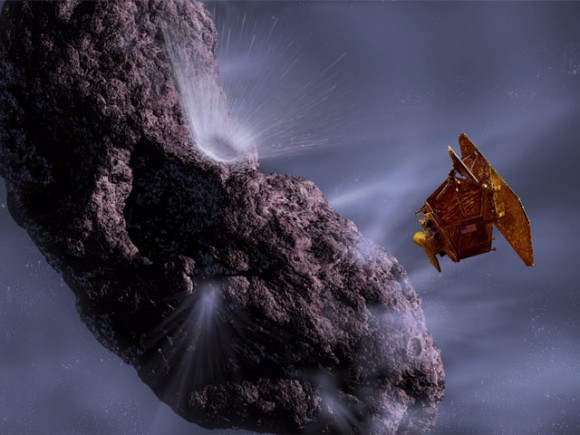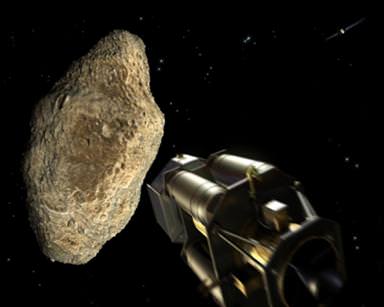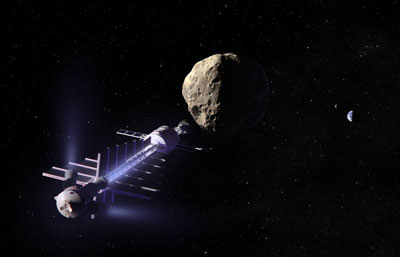Apollo 9 astronaut Rusty Schweickart is among an international group of people championing the need for the human race to prepare for what will certainly happen one day: an asteroid threat to Earth. In an article on Universe Today published yesterday, Schweickart said the technology is available today to send a mission to an asteroid in an attempt to move it, or change its orbit so that an asteroid that threatens to hit Earth will pass by harmlessly. What would such a mission entail?
In a phone interview, Schweickart described two types of “deflection campaigns” for a threatening asteroid: a kinetic impact would roughly “push” the asteroid into a different orbit, and a gravity tractor would “tug slowly” on the asteroid to precisely “trim” the resultant change course by using nothing more than the gravitational attraction between the two bodies. Together these two methods comprise a deflection campaign.

“In a way, the kinetic impact was demonstrated by the Deep Impact mission back in 2005,” said Schweickart. “But that was a very big target and a small impactor that had relatively no effect on the comet. So, we haven’t really demonstrated the capability to have the guidance necessary to deflect a moderately sized asteroid.”
Most important, the gravity tractor spacecraft would arrive prior to the kinetic impactor, precisely determine the asteroid’s orbit and observe the kinetic impact to determine its effectiveness. Following the kinetic impact it would then determine whether or not any adjustment trim were required.
“You want to know what happens when you do a kinetic impact, so you want an ‘observer’ spacecraft up there as well,” Schweickart explained. “You don’t do a kinetic impact without an observation, because the impactor destroys itself in the process and without the observer you wouldn’t know what happened except by tracking the object over time, which is not the best way to find out whether you got the job done.”
So, 10-15 years ahead of an impact threat — or 50 years if you have that much time — an observer spacecraft is sent up. “This, in fact, would also be a gravity tractor,” Schweickart said. “It doesn’t have to be real big, but bigger gets the job done a little faster. The feature you are interested in the outset is not the gravity tractor but the transponder that flies in formation with the asteroid and you track the NEO, and back on Earth we can know exactly where it is.”
Schweickart said even from ground tracking, we couldn’t get as precise an orbit determination of an NEO as we could by sending a spacecraft to the object. Additionally, generally speaking, we may not know when we send an observer spacecraft what action will be required; whether an impact will be required or if we could rely on the gravity tractor. “You may launch at the latest possible time, but at that time the probability of impact may be 1 in 5 or 1 or 2,” Schweickart said. “So the first thing you are going to do with the observer spacecraft is make a precise orbit determination and now you’re going to know if it really will impact Earth and even perhaps where it will impact.”

After the precise orbit is known, the required action would be determined. “So now, if needed you launch a kinetic impactor and now you know what job has to be done,” Schweickart said. “As the impactor is getting ready to impact the asteroid, the observer spacecraft pulls back and images what is going on so you can confirm the impact was solid, –not a glancing blow — and then after impact is done, the observer spacecraft goes back in and makes another precision orbit determination so that you can confirm that you changed its velocity so that it no longer will hit the Earth.”
The second issue is, even if the NEO’s orbit has been changed so that it won’t hit Earth this time around, there’s the possibility that during its near miss it might go through what is called a “keyhole,” whereby Earth’s gravity would affect it just enough that it would make an impact during a subsequent encounter with Earth. This is a concern with the asteroid Apophis, which is projected to miss Earth in 2029, but depending on several factors, could pass through a keyhole causing it to return to hit Earth in 2036.
“So if it does go through that keyhole,” said Schweickart, “now you can use the gravity tractor capability of the spacecraft to make a small adjustment so that it goes between keyholes on that close approach. And now you have a complete verified deflection campaign.”
Schweickart said a Delta-sized rocket would be able to get a spacecraft to meet up with an asteroid. “A Delta rocket would work,” he said, “but if there is a more challenging orbit we might have to use something bigger, or we may have to use a gravity assist and do mission planning for type of thing which hasn’t been done yet. So we can get there, we can do it – but ultimately we will probably need a heavy lift vehicle.”
As for the spacecraft, we can use a design similar to vehicles that have already been sent into space.
“A gravity tractor could be like Deep Space 1 that launched in 1998,” Schweickart said. “ You can make any spacecraft into a gravity tractor fairly easily.”

But it hasn’t been demonstrated and Schweickart says we need to do so.
“We need to demonstrate it because we – NASA, the technical community, the international community — need to learn what you find out when you do something for the first time,” he said. “Playing a concerto in front of an audience is quite different from playing it alone in your house.”


“…..Apophis…..is projected to miss Earth in 2029, but depending on several factors, could pass through a keyhole causing it to return to hit Earth in 2036.”
I had thought that more recent refinement of Apophis’ orbit found little to worry about in 2036 and 2068. From the Wiki entry:
“Additional observations of the trajectory of Apophis revealed the keyhole will probably be missed. On August 5, 2006, Apophis was lowered to a Level 0 on the Torino Scale. As of October 7, 2009, the impact probability for April 13, 2036, is calculated as 1 in 250,000.[6] An additional impact date in 2068 was also identified; the impact probability for that encounter is calculated as 3 in a million.[2][6]”
The European Space Agency has been developing a space probe to study the effects of impactors on asteroids much like that discussed in this article. The Don Quijote mission would involve an orbiter(Sancho) and an impactor(Hidalgo). A ‘Cheap option’ would use a chemical propulsion system and would be sent to Amor asteroid 2003 SM84. A ‘Flexible option’ would employ an electric propulsion system and be tasked to Apophis. Proposed launch dates are in 2013 and 2015. More info: http://en.wikipedia.org/wiki/Don_Quijote_%28space_probe%29
Hopefully this mission, still in the planning stages, can make the leap from the drawing board to the launch pad.
I’m curious, isn’t there a 3rd possible wrinkle to handle NEO’s that buzz Earth a bit too frequently? In some special cases, on the outbound leg from a near miss couldn’t an impactor or gravity tractor be used to set up a collision–with Mercury, Mars, the Moon, another NEO, a comet, etc–instead of always going the route of maneuvering to avoid having the NEO strike Earth by direct action to that effect? If the NEO slams head on into some other celestial body wouldn’t that typically annihilate the threat to Earth from that NEO for all time?
@REDBARON719 ,
Setting up a deliberate asteroid strike on the Moon would probably throw up a lot of material into space, due to the Moon’s low gravity, and that would do our satellites no good at all. The best solution would be to set up the offending asteroid/comet on a collision course with the Sun — it’s a bigger target!
I have thought that one way this could be done without an energy cost would be to deploy mirrors around an asteroid and focus solar radiation on the object. The UV part of the spectrum would ionize the dust on the surface and cause it to ablate off. This would then provide a Newton 3rd law reaction force on the asteroid. In this way we do not have to “pay” for the energy used in impacting or attempting to use small accelerations plus gravity to tug the asteroid away.
LC
Good point that I didn’t consider, I_A_L. Thanks. Scratch the Moon from my list and add the Sun. I still like the idea of putting a final stop to a threatening NEO. The fewer to worry over, the better, I’d think.
Knocking an asteroid into the sun would be really expensive–it’s amazing how much delta-v that takes. The best thing, although this would also be expensive, would be to capture it in a high orbit and then, when we have the technology, send some people up to mine it. Maybe you could get the asteroid to skim through the upper atmosphere to slow it down? Of course, that would be kind of risky, if you miscalculated…
Oh, and does the “space tug” in the first picture remind anyone else of the Discovery 1 from 2001: a Space Odyssey?
Oh, I’m all for mining asteroids. THAT I’ve done some research on, but mostly in the context of doing it in the Main Asteroid Belt beyond Mars. Taken together, there’s almost anything humans have ever mined on Earth–and plenty more of it. One recent NASA estimate placed the total aggregate worth of the mineral wealth of the Main Belt at $600 quintillion…and not 1 ton of it has to be lifted from Earth’s gravity well. OTOH processing minerals and metallic ores in space vacuum ought to be quite the trick. Maybe the Moon does hold the key to all that, which is one of the chief reasons that I think not hurrying back there to develop it as off planet Task #1 is a huge mistake.
Changing the course of an asteroid by a gravity tractor is not very effective, as the gravity force between the two is very very low. One can easily calculate HOW low. If such a low force is apllied to a body (e. g. asteroid) of very high mass, the resulting acceleration caused by the force on that body is so low that it will take many years of action to alter the speed of that body by just one meter per second. Asteroids travel at much, much higher speeds.
Some Asteroids have been photographed by space probes. Each of these photos indicates that these asteroids are not massive space rocks, but huge heaps of boulders, grvel, sand and dust, held together by their own gravity, van-der-Waals-forces and by electrostatic force. Such bodies are nothing to mine in, and nothing more valuable than any stone you may pick up at any quarry next door.
I’ll have to go with Lawrence B. Crowell on this one. Mirror tech. is within our current techno. grasp. A modifiable solar sail gets you to the offending object and then can be reconfigured and used to ablate surface material for a ‘rocket-like’ exhaust. It might even be possible to accelerate the ablated/ionized material with a magnetic field from a superconducting magnet soft landed on the surface?
To save earth the last remaining day is ever more difficult. by landing a powerful electronic diamond shelled mobile drill bit containing a rocket propulsion system on an asteroid equipped with treads for mobile roaming to find the best place on the surface to penetrate launch kinetic force will deflect a killer asteroid safely away from earth up to the last day !
I always liked the idea of hitting a target NEO with a payload of highly absorbent or reflective material. Just like painting it, and let the sun do the rest.
Thanks for the thumbs up. It reallly is a no brainer. Space flight is tightly constrained by mass and energy, or fuel. The smaller, lighter and less complicated you make things the better. Well maybe in the 22nd century we might have fusion powered interplanetary craft that get us to Mars in a week, a space elevator, space colonies like O’Neil’s rotating drums, and …. the whole dreamy stuff. However, for now we are faced with huge limits. So just take up the right minimalist stuff; light weight materials, minimum fuel requirements, and etc, and let solar radiation do the rest.
I will have to look this up, but in Science a couple of years ago there was an article on how asteroids can actually absorb angular momentum from solar radiation and be spun up. So nature does something like this already. What Spoodle58 suggests is similar to to my suggestion. In fact if you characterize a NEO that is dangerous, you might want to spin it up. It might then spin up enough to spit or bifurcate. The two parts might then have enough energy to change their delta-vee enough to avoid Earth.
LC
Some interesting comments on this thread. Thanks to all for furthering my meager knowledge on this topic!
@LC
“I will have to look this up, but in Science a couple of years ago there was an article on how asteroids can actually absorb angular momentum from solar radiation and be spun up. So nature does something like this already. What Spoodle58 suggests is similar to to my suggestion. In fact if you characterize a NEO that is dangerous, you might want to spin it up. It might then spin up enough to spit or bifurcate. The two parts might then have enough energy to change their delta-vee enough to avoid Earth.”
Might you be referring to the YORP effect? http://en.wikipedia.org/wiki/Yarkovsky%E2%80%93O%27Keefe%E2%80%93Radzievskii%E2%80%93Paddack_effect
(spinning up an asteroid to avoid impact sounds very interesting…hopefully we could test this mechanism out on a non-threatening asteroid in the near future)
@H_S_A
“Oh, and does the “space tug” in the first picture remind anyone else of the Discovery 1 from 2001: a Space Odyssey?”
Yeah, every time I see this illustration (it tends to get used quite a bit). 🙂
The YORP effect it is.
LC
The Yorp effect, cheers Jon & LC. Must read up on this, I wonder if any testing or study has been done on this.
I do agree this stuff needs to stay as simple as possible.
S58